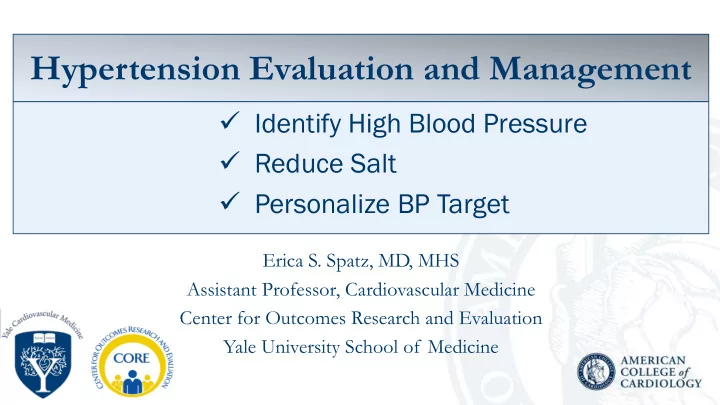

Hypertension Evaluation and Management ü Identify High Blood Pressure ü Reduce Salt ü Personalize BP Target Erica S. Spatz, MD, MHS Assistant Professor, Cardiovascular Medicine Center for Outcomes Research and Evaluation Yale University School of Medicine
Disclosures • Develop outcome measures under a contract with the Centers for Medicare and Medicaid Services (CMS) • NIH/NIMHD funded U54. Project Lead: Health Disparities in Hypertension: A Precision Medicine-based Approach for Early Risk Stratification
Hypertension: The Silent Killer
Hypertension: A Global Health Crisis 26% 26% 45% 45% 29% 29% Forouzanfar MH, JAMA . 2017
Higher burden of st stroke in low and middle income regions. HTN accounted for 14% of deaths (>10 million) & >212 million DALYs in 2015 1.4-fold increase since 1990 Forouzanfar MH, JAMA . 2017
China: Million Persons Project Overall, ½ of adults aged 35 to 75 had HTN Only 1/3 were treated 1 in 12 were controlled (<140/90) Lu J, Lu Y. Lancet .,2017
HTN in the US: A Tale of “2” Cities Bronx and other parts of Brooklyn, Manhattan HTN rates of and Brooklyn 30-40% Heights, HTN rates of 16-25%
US Hypertension Prevalence RACE RA IN INCOME 18 and Over 25 and Over Age-Adjusted <100% FPL 100-300% FPL >300% FPL Prevalence 29% 50.8% 50.8% 40.3% White 28% FPL: Federal Poverty Level Black 42% Hispanic 26% Asian 25% Beckman AL…Spatz ES. JAMA Cardiology , 2017; Wang YC...Schwartz JE Am J Epidemiol, 2017
The problem is likely much worse. Other phenotypes of hypertension, typically not measured, also portend worse cardiovascular outcomes.
Evaluation: Phenotypes of HTN Nocturnal Masked Non- HTN HTN Dipping Wang YC...Schwartz JE Am J Epidemiol, 2017
Masked HTN NIMHD Precision Medicine Grant: ABPM Trajectory Phenotypes
ACC/AHA 2017 Guidelines
ACC/AHA 2017 Guidelines
Evaluation Summary • Personalized, Population Health Approach – Engage persons inside and outside of the medical setting – Focused screening: populations at risk; families; networks – Attention to contextual environment • Diagnosis of HTN – Home-based monitoring – 24-hour ABPM – Develop cheap, convenient BP detection devices
Hypertension Management To reach BP goal of 120/80 mmHg and… to improve cardiovascular outcomes ?
A Global Taste of Salt Intake • Salt intake is high across the globe. • N America 4-5 g/d of sodium (goal <2.3 g/d) • Central, Asian Pacific, East Asia, and Eastern Europe have the highest salt intake Powles, J et al. BMJ Open . 2013
Will lowering salt reduce CV risk? 😈 Population Level 😈 😕 Individual Level 😕 We eat too much salt. At an individual level, yes Lower sodium intake is in some populations, associated with lower though its difficult and blood pressure and the benefits are less fewer cardiovascular certain. events Menta A (PURE); O’Donnell MJ (PURE), Mozaffarian D, (NutriCode). NEJM, 2014
Salt Reduction: Challenge “The issue is not what you do with your salt shaker.” --David Katz, MD Yale University Preventive Medicine
Salt Reduction: Individual Level
Personalized Approach
Individualize based on risk ü Personal evidence of target organ damage ü Family hx of stroke, CAD, blindness or renal disease
Individualize based on risk SPRIN INT AC ACCORD HO HOPE 3 Goal Treat to Target Treat to Target Fixed dose med trial Strategy tested <140 vs <120 <140 vs <120 ARB/thiazide v. placebo In In w whom? High r risk p patients Di Diab abetes In Intermediate r risk What worked? <120 mmHg <140 mmHg <140 mmHg At what expense? ++ meds More side effects No difference in ++ side effects (renal) discontinuation (25% resulting in ED visits both arms) At what benefit? 25% RRR in MACE, No difference in Benefit restricted to (no reduction in MI MACE or death. group with systolic or stroke) Fewer strokes. BP >142 mmHg
Shared Decision Making • Personalize identification and characterization of BP patterns • Assess BP in context of overall CV risk • Co-design goals • Find therapies with the least burden • Manage contributors to hypertension – lifestyle, stress • Openly address adherence
A person-centered approach takes a health system Health P Promotion Assess R Risk F Factors ü Personalize ü Diet diagnosis ü Physical Activity ü Elicit ü Stress preferences and ü Weight goals ü Social context ü Do shared ü Physical env decision making ü SES ü Improve health ü Access to care system support ü Out of pocket ü Continued costs feedback and realignment
Recommend
More recommend